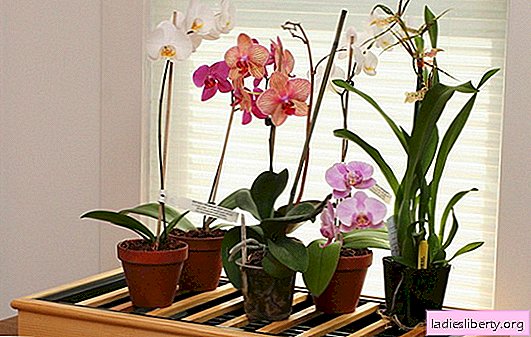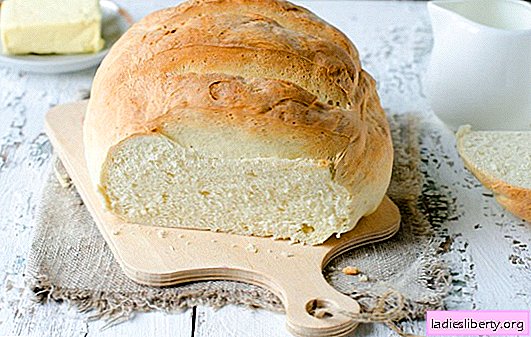
Orchid - an exotic flower, loved by many gardeners.
However, there is an opinion that the cultivation of orchids is a very difficult task and only professionals can do it.
But this is far from the case.
You can learn how to properly care for orchids.
Orchid cultivation at home
If the flower purchased in the store has begun to lose its decorative effect and is not happy with flowering, then you should think about the conditions of detention. For the plant you need a suitable microclimate, which can be created in an apartment. Beginners are advised to get a Phalaenopsis orchid.
Choosing a location for phalaenopsis
One of the important factors in orchid care is light. Insufficient lighting inhibits plant growth, flowering is delayed. Keep in mind that the flower does not tolerate direct sunlight. It is better to place the pot with the plant on the eastern or western windows. Daylight hours for phalaenopsis should be at least 12-14 hours.
Creating a microclimate for the plant
Sufficient air humidity is an equally important point for successful flower cultivation. Humidity at the level of 70-75% is considered a necessary norm. Spraying the plant during the hot season will help maintain a favorable microclimate around it. You need to irrigate the bottom of the sheet so that water does not get inside the outlet or on the flowers.
In winter, you need to take care of ventilating the room. But leave the flower pot in the draft is not worth it. In a room with central heating, increase air humidity. For these purposes, the pot is placed on a tray with expanded clay, which is poured with water.
Important! There must be a distance between the pot and the pan for good ventilation of the root system. A pot with an orchid should not stand in water.
The temperature regime of orchids
The secret of the regular appearance of peduncles in the proper care of orchids. Phalaenopsis are divided into several types:
• Heat-loving plants that prefer elevated temperatures. They will take root well in a room where the temperature ranges from 18 to 26 degrees.
• Varieties that prefer moderate heat. Such flowers grow at medium temperatures from 13 to 18 degrees.
• Plants for cool rooms. They develop well at low temperatures from 8 to 13 degrees.
To book flower buds, you need to maintain the difference between day and night temperatures. It is this technique that stimulates the plant to further prolonged flowering.
The role of watering in orchid cultivation
Watering a plant is directly dependent on the environment. If the plant is located in a cool room, then watering is reduced. Phalaenopsis prefer moderate watering. But in a stuffy room in the summer, you need to take care of regular frequent watering.
When watering, you need to make sure that the roots of the plant do not get wet. Excess moisture should go into the pan. The next watering should be carried out only when the substrate in the pot dries.
The absence of condensation on the walls of the pot indicates the need for watering.
For irrigation, you need to use only standing water, the temperature of which is slightly higher than room temperature. It is better to apply watering in the pan. In this case, excess water, not absorbed by the roots, must be poured. You can not water the orchid from above. This can lead to decay of the outlet and death of the flower.
It is better to carry out regular watering in the morning, so that the substrate dries out in a day. Lowering nighttime temperatures and too moist soil is an excellent environment for the development of diseases.
Tips for proper orchid care during flowering
How long a beloved plant will delight with flowering depends not only on species characteristics, but also on proper care, conditions of detention.
For the bookmark and the emergence of new flower buds, the plant needs stress. Experienced growers practice temperature and watering. The flower is placed in a cooler room and reduce watering, after a while it is returned to its original place, gradually increasing watering.
Once the orchid has bloomed, you need to alternate watering and feeding. The root system of an exotic plant is very capricious, top dressing is carried out with special fertilizers.
What to do with an orchid after flowering
Whether the flower blooms again depends on the proper care that the orchid needs after flowering.
Creating a favorable microclimate is not all that a plant needs during this period. Proper care of orchids after flowering is slightly different.
1. Once the flowering is over, take your time to cut the peduncle. It is a source of plant nutrients.
2. Sometimes new buds immediately appear on the peduncle and flowering continues.
3. Cut the peduncle after it dries, touching live tissue. It is desirable to smear the place of the cut with green. This will protect the plant from disease.
4. If the peduncle does not dry out for a long time, and new buds do not appear, you can cut it above the level of sleeping buds. This procedure stimulates new flowering.
5. When the dormant period has come to the orchid, you need to give the plant a rest. At this time, it is better to reduce watering and top dressing.
6. An orchid transplant is carried out only during the dormant period.
It is important to remember that each type of orchid has its own resting period.

How to transplant an orchid
Transplant an indoor orchid as needed. Often the plant is transplanted into a larger pot with soil replacement.
A transplant should be done every two to three years. If this is not done, then the soil accumulates excess salts, loses its breathability. As a result, the plant becomes susceptible to diseases and pests.
Do not transplant a plant if it is preparing for flowering. This will slow the growth of flower buds and the dropping of unopened buds.
A good time for a transplant is to build up new roots. The pot needs to be picked up slightly larger than the previous one. Novice gardeners are recommended to purchase transparent pots. They clearly show the condition of the soil, the horse system of the plant, which will help the breeder to establish the desired irrigation regime.
The pot for planting should be plastic. At the bottom you need to make holes to drain the water. For orchids, you need a special substrate, which has good breathability. It consists of moss, tree bark, peat and coal. You need to purchase a quality substrate in specialized stores.

Propagation of orchids at home
Not many flower growers manage to successfully propagate phalaenopsis at home. Reproduction of the plant is a rather laborious process. But properly caring for orchids, you can achieve positive results.
There are several ways to propagate orchids:
• dividing the bush;
• cuttings;
• subsidiary layering.
In order to successfully propagate orchids, you need to determine what species the plant belongs to.
The types of orchids that grow and form daughter rosettes are quite easy to propagate. It is enough to separate the outlet with the roots during transplantation and plant it in the prepared substrate.
There are orchids that form daughter branches. They are formed in the axils of the leaves or on the peduncle. You can separate them without much effort.
Propagation of orchids by cuttings is the most difficult way. But if there are no other options, you will have to learn how to propagate the plant by a cuttings.
For cuttings, you need to choose young shoots. The cut is done with a sharp knife, right above the leaf of the plant. You need to cut the shoot into separate cuttings of not more than 20 cm. Each piece received must have one or more sleeping buds.
Sections are treated with brilliant green or crushed coal. Ready cuttings are dried in the open air during the day. You need to plant the cuttings in a prepared substrate for orchids, which is watered in advance. Cuttings are pressed to the surface of the soil, slightly falling asleep. A container with cuttings must be put in a greenhouse to maintain high soil moisture. The greenhouse needs to be aired daily.
Cut orchids at a temperature of at least 25 degrees. After a month in the greenhouse you can see young shoots.

Orchid Diseases
Orchids are affected by various viral diseases. Most often, the roots and leaves of the plant suffer. If various spots appeared on the leaves, then we can talk about fungal diseases.

Suspicious leaves of the plant need to be cut off, and the places of the cuts should be treated with green. The diseased plant should be isolated from other species of orchids.
Of the pests, orchids are affected by aphids, scale insects and mealybugs. If pests are found, the plant is treated with special preparations.
Orchid shield

Root rot can be suspected by the presence of a specific smell from the substrate. The plant fades, the roots are damaged, and the soil is covered with mycelium of the fungus. You can save the plant by transplanting it into a disinfected substrate. Before planting, the roots of the plants are washed under running water, damaged areas are removed.

General recommendations for choosing an orchid
Before buying a plant, determine the name of the species, inspect it for pests. At home, create the most comfortable climate for the growth and development of the orchid, then it will delight in flowering. Avoid overcooling plants and protect from drafts. Regularly evaluate the appearance of the orchid, for timely action in case of illness.











